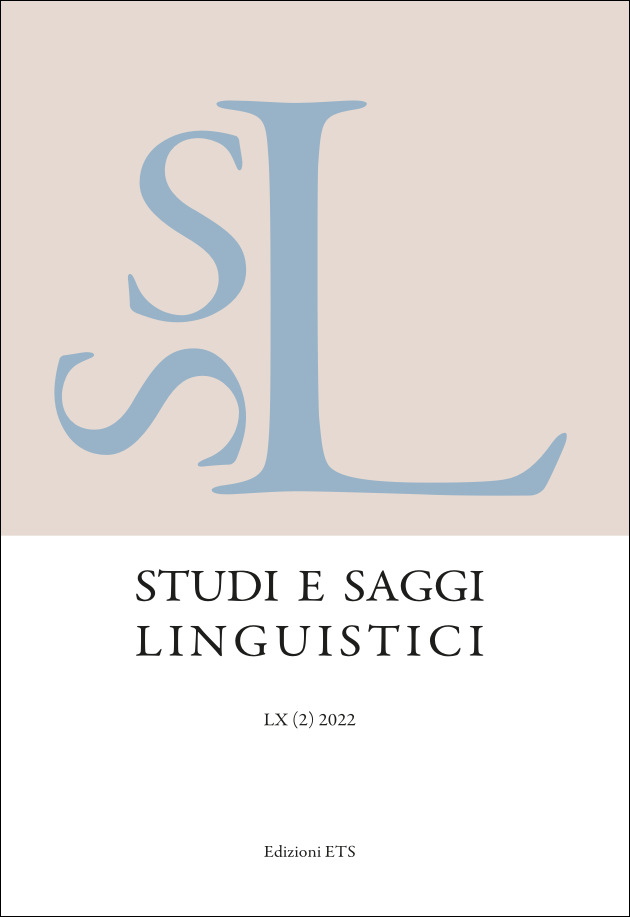Published 2022-12-24
Keywords
- Ancient Greek, secondary predicates, resultatives, causatives
Abstract
This paper investigates syntactic and semantic properties of a rare Euripidean use of the verb διδάσκω, occurring in gnomic expression and describing the effect of passions on human beings, where a predicative adjective refers to the direct object. Through a contrastive analysis with its rephrasings by ancient authors, who replace διδάσκω with ποιέω, the pattern is argued to involve a resultative secondary predication, since the similarities and differences singled out correspond to the well-known contrast between causative and resultative structures. Accordingly, unlike what is generally assumed, Ancient Greek attests – although confined to tragedy – resultative constructions, a pattern particularly productive in Germanic languages, where it has been explored in depth.
References
- BATTEZZATO, L. (2020), The Language of Euripides, in MARKANTONATOS A. (2020 ed.), Brill’s Companion to Euripides, Vol. 1, Brill, Leiden/Boston, pp. 545-570.
- BEAVERS, J. (2012), Resultative constructions, in BINNICK, R.I. (2012, ed.), The Oxford Handbook of Tense and Aspect, Oxford University Press, Oxford, pp. 908-933.
- BENEDETTI, M. (2020), Ditransitive ‘teach’ and the status of the Theme “argument”(?): Greek διδάσκειν as a case study, in «Journal of Greek Linguistics», 20, 2, pp. 153-178.
- BENEDETTI, M. (2021), “Love teaches”: echoes of a fragment from Euripides, in GIANNAKIS G.K., CONTI, L., DE LA VILLA, J. e FORNIELES R. (2021, eds.), Synchrony and Diachrony of Ancient Greek: Language, Linguistics and Philology (Trends in Classics - Supplementary Volumes, 112), De Gruyter, Berlin/Boston, pp. 397- 402.
- BRUNO, C. (2013), Gr. ποιέω: note di sintassi, in: LORENZETTI, L. e MANCINI, M. (2013, a cura di), Le lingue del Mediterraneo antico. Culture, mutamenti, contatti, Carocci, Roma, pp. 69-82.
- BRUNO, C. (2014) ḖCHŌ-perfects in Greek: a diachronic view, in BARTOLOTTA, A. (2014, ed.), The Greek Verb: Morphology, Syntax, Semantics, Peeters, Louvain-La-Neuve/Walpole, Mapp, pp. 43-52.
- COCK, A.J.C.M (1981), Ποιεῖσθαι : ποιεῖν. Sur les critères déterminant le choix entre l'actif Πoiein et le moyen, in «Mnemosyne», 34, 1-2, pp. 1-62.
- CROFT, W. et al. (2010), Revising Talmy’s typological classification of complex event constructions, in BOAS, H. (2010, ed.), Contrastive Studies in Construction Grammar, John Benjamins Publishing Company, Amsterdam/Philadelphia, pp. 201-236.
- CROPP, M. (1988), Euripides’ Electra, Aris & Phillips, Warminster.
- DUBINSKY, S. (1985), Japanese union constructions: a unified analysis of -sase and -rare. PhD dissertation, Cornell University.
- GOLDBERG, A. e JACKENDOFF, R. (2004), The English Resultative as a Family of Constructions, in « Language», 80, 3, pp. 532-568.
- HALLIDAY, M.A.K. (1967), Notes on transitivity and theme in English, Part 1, in «Journal of Linguistics», 3, pp. 37-81.
- HIMMELMANN, N.P. e SCHULTZE-BERNDT, E. (2005), Secondary Predication and Adverbial Modification, Oxford, Oxford University Press.
- HORROCKS, G. e STAVROU, M. (2003), Actions and their Results in Greek and English: The Complementarity of Morphologically Encoded (Viewpoint) Aspect and Syntactic Resultative Predication, in «Journal of Semantics» 20, 3, pp. 297-327.
- KÜHNER, W.R. e GERTH, B. (1898), Ausführliche Grammatik der griechischen Sprache3. II-2, Hahnshe, Hannover/Leipzig.
- LA FAUCI, N. (2009), Compendio di sintassi italiana, il Mulino, Bologna.
- LEVIN, B. (2020), Resultatives and Constraints on Concealed Causatives, in BAR-ASHER SIEGAL E.A. e BONEH N. (2020, eds.), Perspectives on Causation, Cham, Springer, pp. 185-217.
- RIST, J. M. (2001), Plutarch's “Amatorius”: A Commentary on Plato's Theories of Love? , in «The Classical Quarterly», 51, 2, pp. 557-575.
- RAPOPORT, T.R. (1993a), Stage and Adjunct Predicates: Licensing and Structure in Secondary Predication Constructions, in REULAND, E. E ABRAHAM, W. (1993, eds.), Knowledge and Language, Vol. II, Lexical and Conceptual Structure, Dordrecht/Boston/London, Kluwer Academic Publishers, pp. 157-182.
- RAPOPORT, T.R. (1993b), Verbs in depictives and resultatives, in PUSTEJOVSKY, J. (1993, ed.), Semantics and the Lexicon, Dordrecht/Boston/London, Kluwer Academic Publisher, pp. 163-184.
- RAPOPORT, T.R (2019), Secondary predication, in TRUSWELL, R. (2019, ed.), The Oxford handbook of event structure, Oxford University Press, Oxford, pp. 426- 455.
- RAPPOPORT HOVAV, M. e LEVIN, B. (2001), An event structure account of English resultatives, in «Language», 77, pp. 766-797.
- ROTHSTEIN, S. (2006), Secondary Predication, in EVERAERT, M. e VAN RIEMSDIJK, H.C. (2017, eds.), The Blackwell Companion to Syntax, Volume IV, Blackwell, Malden/Oxford/Victoria, pp. 209-233.
- SCHWYZER E. e DEBRUNNER A. ([1950]1988), Griechische Grammatik, Zweiter Band, Syntax und Syntaktische Stilistik, Beck, München.
- TALMY, L. (1985), Lexicalization patterns: semantic structure in lexical forms, in SHOPEN, T. (1985, ed.), Language typology and syntactic description, Cambridge University Press, Cambridge, pp. 36-149.
